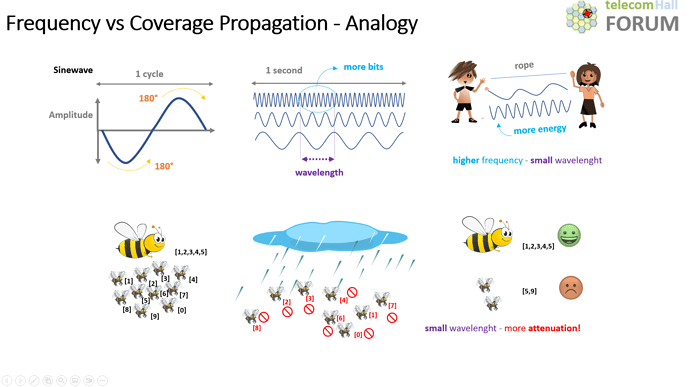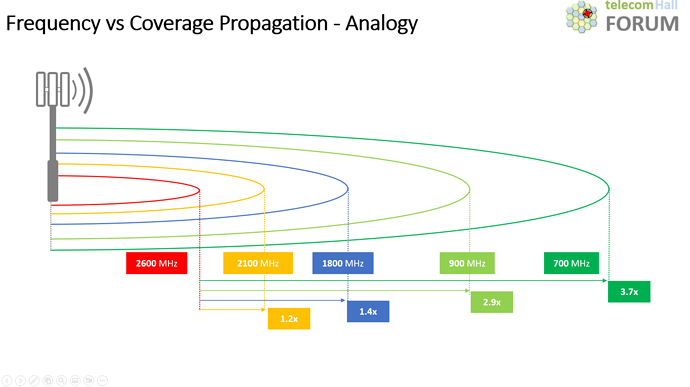Download Slide
Frequency vs Coverage Propagation - Analogy.xlsb (248.9 KB)
Frequency vs Coverage Propagation - Analogy.pptx (290.1 KB)
Slide Notes
Radio frequency waves are invisible and undetectable to our human ear, but they are the essence of modern communication technologies.
Radios and devices can distinguish between different channels based on frequency - this is what allows us to have thousands of channels all in the same space without interference.
But to begin with, what is frequency? Also, what happens if we vary the frequency (higher, lower…)?
No, it’s not worth saying that it’s because of the “formula”. ![]()
Let’s start by imagining a sine wave signal, because although they are not found in nature, they help a lot when we need to explain frequency.
When the signal oscillates 360 degrees, it completes one cycle. The number of complete cycles in 1 second is what we call Frequency. 1 cycle completed in 1 second is called 1 Hertz.
700 million cycles per second: this means a frequency of 700 million Hertz (or as it is usually shown: 700 MHz).
Just as a curiosity, the sound that the human ear can hear ranges from 20 Hertz to 20,000 Hertz.
Let’s continue.
In a simplified way, let’s divide the frequencies into low frequency (or as called in 5G sub-6 GHz - which actually changed to sub-7 GHz) and high frequencies like the millimeter wave bands which are at much higher frequencies than those commonly used in 4G.
A phrase well known by all those who work with mobile networks: the lower the frequency, the greater the coverage area.
Although the statement is correct, and therefore, if it is “memorized” it is valid in the same way, many people do not really know how to explain why this is so.
Simply saying that the wavelength is longer - if the frequency is lower - does not “explain” why we have shorter range.
So let’s explain. And for that we will first understand some concepts in a simplified way.
Starting with the absorption of energy from electromagnetic waves. And another well-known statement: “‘Small’ waves are more attenuated than ‘large’ waves when transmitted through a medium!”
At first it also seems to make no sense, so let’s understand with an analogy.
Imagine 1 bee (size - wave - big) and 10 mosquitoes (size - wave - small).
Imagine that you have some information to be transmitted, both by the bee and the mosquitoes: [1,2,3,4,5,6,7,8,9,0]
The bee will make two trips: first it will take package [1,2,3,4,5] and then package [6,7,8,9,0]
Mosquitoes will be able to take the package in one go: [1,2,3,4,5,6,7,8,9,0]
Sounds better then hiring the mosquitoes for the job, doesn’t it?
The problem is that, depending on the conditions of the transmission medium, the signal may interfere with different types of signals and be attenuated. ![]()
Imagine for example that it is raining.
Many mosquitoes can end up getting hit by raindrops, and losing the information they carried.
In 2 trips the bee manages to take all the information (reliability), while the mosquitoes must repeat the trip several times (retransmission) until they manage to take all the bits.
Of course, if it’s not raining (nor windy, etc.) the mosquitoes would be able to carry the information. It would be, for example, the case of a short distance, with a direct line of sight - but this situation is not always easy to find.
With this example, we understand that higher frequencies, with shorter wavelength suffer more attenuation.
With that understood, let’s continue.
Higher frequencies have higher energy - as they oscillate faster (more frequently) than lower frequencies of the same amplitude.
Imagine for example 2 people holding a rope. To make the string oscillate more requires more energy!
If we count the peaks and valleys we get many more (peaks and valleys) at the higher frequency. I can put a lot more data (more bits) in it, that is, it is denser, it has more information density. I can vary the amplitude or frequency or phase many more times compared to the lowest frequency.
But of course, as waves travel through a medium, they lose energy and are damped, so they can only travel a limited distance. This distance is calculated in the Link Budget, and includes a number of variables and factors, including air viscosity including dust and humidity. This is the calculated maximum distance to the point where the signal is so weak that it is no longer understandable. But this is a topic for another topic.
Let’s go ahead.
We understand then that when a signal propagates for example in free space, it suffers an attenuation of the radio energy between the feeding points of the two antennas (receiver and transmitter). Low frequency waves travel farther than high frequency waves because less energy is transferred to the medium. Less attenuation.
And this is one of the main reasons why we say that lower frequencies are better for mobile communication - because the signals have better penetration, that is, they pass through objects like walls with less attenuation (also another topic that will be covered in another topic) .
This is why for example lower frequencies (like 700 MHz) reach “further” than higher frequencies like (2600 MHz). Low frequencies - long wavelength - allow for example waves to be more diffracted around edges, for example practically bending over obstacles like hills and even reaching places even if the source cannot be seen.
Now we have already managed to make a summary, and understand that in wireless communication we have a “compensation”.
If we increase the frequency we increase the amount of data (bits) we can transport, the energy. (Example of 2 people swinging a rope)
But the higher frequency has a shorter wavelength and thus increases penetration. (Example of the bee and mosquitoes)
If the signal is attenuated, its intensity is reduced.
And by reducing the strength of the signal, we also decrease the distance it can travel.
Just to conclude, although our example is using mobile networks, the concept applies to anything involving mobile data transmission, including the Wi-Fi you have in your home.
Most likely, you have a model that has 2 bands: 2.4 GHz and 5 GHz. But why that?
Because 2.4 GHz doesn’t transmit as much information (it’s not as fast) as 5 GHz, but on the other hand it reaches farther.
If you are in a place in your house with good signal conditions, you will use 5 GHz and upload / download faster, you will transmit better.
But if the location has bad conditions (for example if you have to go through one or more walls to pass between the wifi transmitter and your device) you will use the 2.4 GHz as you need to get enough signal to be reliable, at the lowest frequency.
In conclusion for today: Whether it’s mobile cellular networks, your home’s Wi-Fi or any other wireless communication system, if you understand the basic concepts presented you won’t have a hard time understanding why lower frequencies reach farther!

